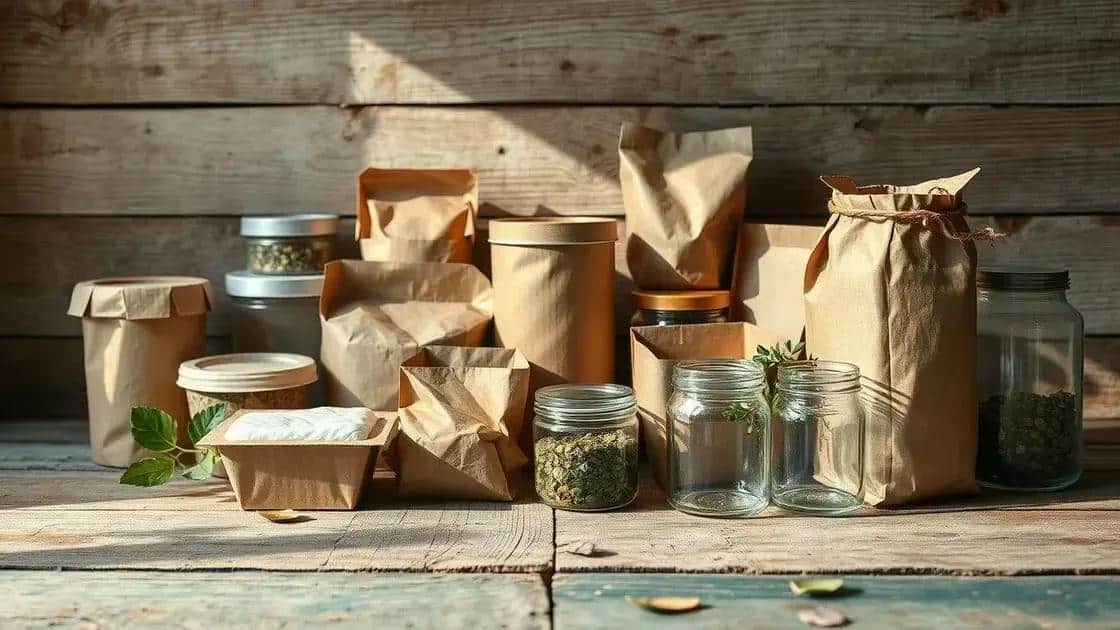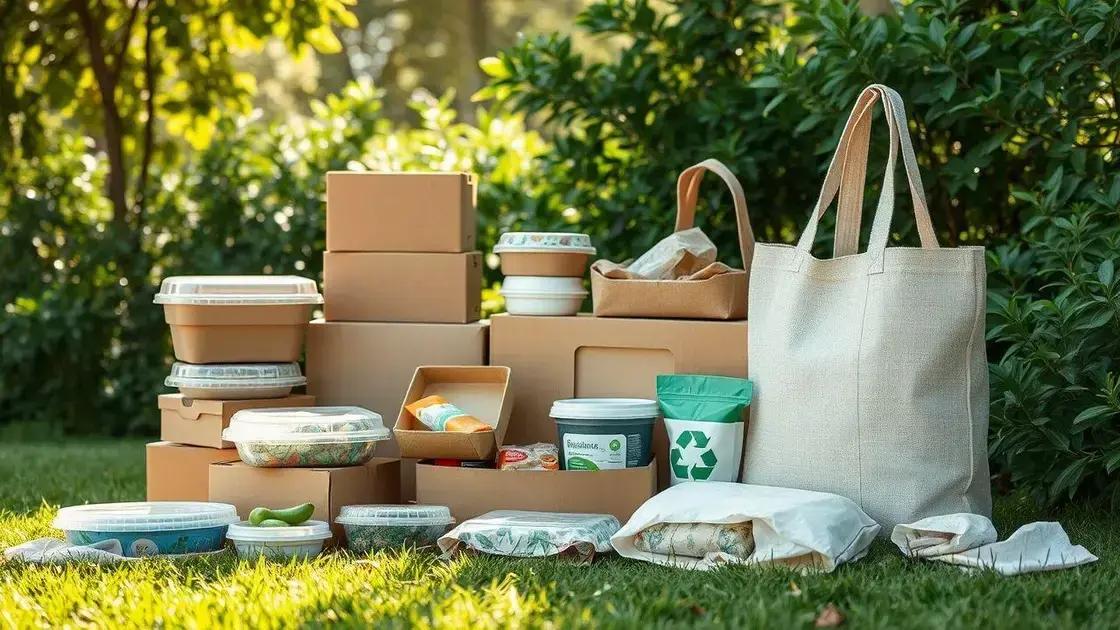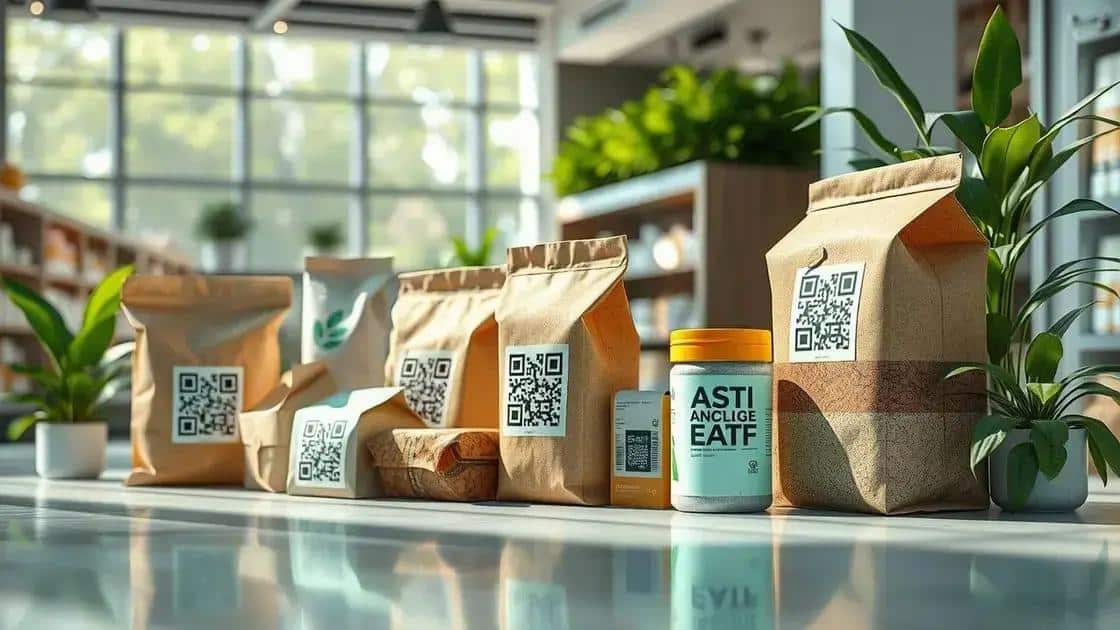Insights on sustainable packaging news: why should you care?

Sustainable packaging involves using materials that are recyclable, biodegradable, or compostable, helping to minimize environmental impact while enhancing brand reputation among eco-conscious consumers.
Insights on sustainable packaging news are more relevant than ever, especially for those concerned about the environment. Have you considered how your product’s packaging impacts our planet? Let’s dive into how these innovations are reshaping our consumption habits.
What is sustainable packaging?
Sustainable packaging refers to packaging solutions designed to have minimal environmental impact. It is made from materials that are either recyclable, compostable, or biodegradable. This helps reduce waste and pollution, contributing to a healthier planet.
Types of sustainable packaging
There are various types of sustainable packaging that organizations can adopt. These include:
- Biodegradable materials: These materials break down naturally over time, reducing landfill waste.
- Recyclable packaging: Items that can be processed and re-used in new products, promoting a circular economy.
- Reusable packaging: Durable containers that can be used multiple times, cutting down on the need for single-use items.
- Compostable materials: Packaging that can decompose into nutrient-rich soil when placed in a composting environment.
Implementing sustainable packaging can be beneficial not only for the environment but also for businesses. By using eco-friendly alternatives, companies can enhance their brand image and appeal to eco-conscious consumers. Adopting such practices signifies a commitment to sustainability that resonates with customers.
Why sustainable packaging matters
As awareness grows, understanding the importance of sustainable solutions is essential. The proliferation of single-use plastics has led to significant environmental concerns, such as pollution and harm to wildlife. By shifting to sustainable options, we can mitigate these impacts and encourage responsible consumption habits.
Each individual choice contributes to a larger impact. Even small changes can lead to significant benefits for the environment. Every time consumers opt for products that use sustainable packaging, they play a part in reducing waste and promoting a circular economy. As more people recognize this, the demand for eco-friendly options will continue to rise.
In conclusion, sustainable packaging is crucial for minimizing environmental damage while supporting businesses through positive consumer perception. As we move forward, embracing these innovative solutions can lead to a healthier, more sustainable future.
Benefits of adopting eco-friendly packaging

Adopting eco-friendly packaging offers numerous advantages for businesses and the environment. By utilizing materials that are recyclable, biodegradable, or made from renewable resources, companies can significantly reduce their carbon footprint. This shift not only benefits the planet but also enhances a brand’s reputation among consumers.
Environmental impact
One of the primary benefits of eco-friendly packaging is its positive effect on the environment. Sustainable materials help decrease pollution and waste in landfills. They also reduce reliance on fossil fuels used in the production of traditional packaging. By making this switch, companies contribute to a healthier ecosystem.
- Reduction in landfill waste: Eco-friendly packaging materials break down more easily than conventional plastics, leading to less waste accumulation.
- Lower carbon emissions: Sustainable packaging often requires less energy to manufacture, which diminishes greenhouse gas emissions.
- Conservation of resources: Using renewable materials helps conserve natural resources, preventing depletion and ensuring availability for future generations.
- Protection of wildlife: Reducing plastic waste ultimately benefits wildlife, as fewer animals are harmed by litter and pollution.
Additionally, using eco-friendly packaging can drive customer loyalty. Today’s consumers are increasingly conscious of their choices. They prefer brands that prioritize sustainability. This creates a competitive advantage for businesses that adopt environmentally friendly practices.
Cost-effectiveness
While some may believe that sustainable packaging is costlier, many eco-friendly options offer long-term savings. By investing in reusable or recyclable packaging, companies can reduce their expenses over time. They can also benefit from incentives and support from government programs promoting sustainability.
In summary, adopting eco-friendly packaging not only benefits the environment but also enhances brand image and offers economic advantages. Embracing these practices paves the way towards a more sustainable future.
Recent innovations in sustainable packaging
Recent innovations in sustainable packaging are transforming how products are packaged and consumed. Many companies are embracing new technologies and materials that minimize their environmental impact while ensuring safety and functionality. This shift is essential as the demand for eco-friendly solutions continues to grow.
Plant-based materials
One exciting development is the use of plant-based materials in packaging. These materials are derived from renewable resources and offer a promising alternative to traditional plastics. Companies are now using materials like corn starch and sugarcane to create packaging that decomposes more naturally.
- Bioplastics: Made from organic materials, these plastics are designed to reduce reliance on fossil fuels.
- Compostable packaging: Innovative designs allow packaging to break down in composting environments, returning nutrients to the soil.
- Edible packaging: Some companies are even creating packaging that can be consumed along with the product, reducing waste.
In addition to plant-based options, advances in recyclable packaging have gained traction. More brands are designing packaging that is easier to recycle, making it possible for consumers to dispose of it responsibly. This improvement ensures that more materials are repurposed rather than ending up in landfills.
Smart packaging technologies
Another innovation making waves is smart packaging. This technology includes features like QR codes and sensors that provide information on freshness and proper disposal methods. These additions help educate consumers and promote sustainable practices.
Furthermore, companies are employing new methods for reducing the amount of packaging used. By moving towards minimalist designs, businesses can lessen their environmental impact in significant ways. This method not only conserves resources but also reduces shipping costs.
As these innovations continue to unfold, the future of sustainable packaging looks promising. Brands are progressively stepping up their game by adopting these new technologies, paving the way for greener practices across industries.
Future trends in sustainable packaging

The future of sustainable packaging is bright, with many exciting trends on the horizon. As consumers become more environmentally aware, the demand for innovative solutions is increasing. This evolution in packaging will not only help the planet but also reshape how companies approach their product designs.
Increased use of recyclable materials
One prominent trend is the increased use of recyclable materials in packaging. Companies are investing in research to develop packaging that is easier to recycle. This shift reduces waste and encourages consumers to dispose of products responsibly.
- Post-consumer recycled content: More brands are incorporating materials recycled from previous products into their packaging.
- Simplified packaging: By minimizing packaging layers, companies are making it easier for consumers to recycle.
- Design for disassembly: Some packaging designs allow consumers to easily separate components, improving recycling rates.
Additionally, biodegradable materials are gaining popularity. Expect to see more products made from materials that can break down naturally in the environment. These eco-friendly alternatives will help reduce the burden on landfills and promote healthier ecosystems.
Smart technology adoption
Another future trend involves the adoption of smart technology in packaging. This includes features like QR codes and augmented reality, which allow consumers to learn more about the product’s sustainability. Such innovations also provide information on proper disposal methods.
As supply chains become more transparent, companies and consumers alike will benefit. Tracking the sourcing and impact of packaging materials will help promote more sustainable choices throughout the production process.
Furthermore, brands will increasingly focus on sustainable branding. Companies that emphasize their commitment to sustainability can attract eco-conscious customers. This trend will make environmental stewardship a key part of brand identity moving forward.
The integration of sustainable packaging into everyday products is no longer a niche approach; it’s becoming a standard expectation. As these trends continue, businesses that adapt will not only survive but thrive in the evolving marketplace.
FAQ – Frequently Asked Questions about Sustainable Packaging
What is sustainable packaging?
Sustainable packaging refers to packaging solutions made from materials that are recyclable, biodegradable, or compostable, reducing environmental impact.
Why is sustainable packaging important?
It helps to minimize waste, conserve resources, and protect wildlife, while also improving a brand’s reputation among eco-conscious consumers.
What are some examples of innovative sustainable packaging materials?
Examples include bioplastics made from plant materials, compostable packaging, and reusable containers designed for multiple uses.
How can businesses benefit from using sustainable packaging?
Businesses can enhance their brand image, attract customers, and potentially save on costs by adopting more efficient packaging solutions.





